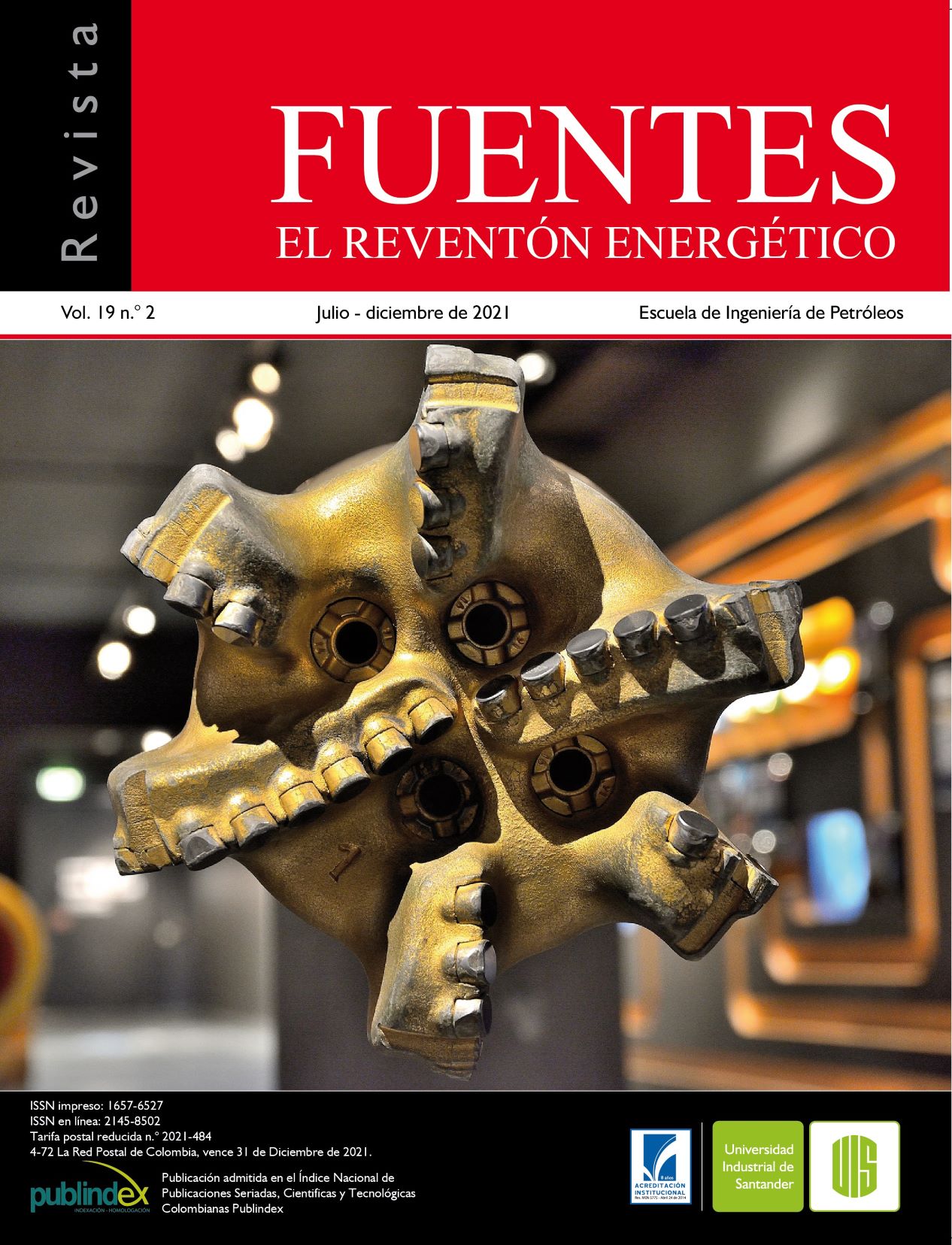Pilot study for the Injection of Bactericides in Sands with Microbial Activity Problems in the Libertador Field, Block-57
Published 2021-12-24
Keywords
- Sulfate-reducing bacteria,
- corrosion,
- non-reactive matrix stimulation,
- biocides
How to Cite
Copyright (c) 2021 Universidad Industrial de Santander

This work is licensed under a Creative Commons Attribution 4.0 International License.
Abstract
Microbial activity can lead to problems such as corroded tubing, formation plugging, and decreased effective permeability, especially the sulfate-reducing bacteria that have the formation water as a medium that allows their proliferation. These adhere to the conductive channels of the producing sand and form biomass that restricts the flow of fluids. This work was carried out to design a non-reactive matrix stimulation by injecting biocides that clean the sand face to increase permeability, reduce formation damage, control corrosive environments, and increase daily oil production. By analyzing the total concentration of iron, sulfate, carbon dioxide, sulfide in gas and water, wells with microbial activity were identified, while the behavior of the bacteria was characterized by evaluating bacterial cultures and corrosion coupons. Using economic profitability criteria, the TTT A 011 and TAP 09 wells were selected as the most prospective in the Libertador field since, out of the 94 wells analyzed, they presented the highest index of microbial activity and recovery of oil barrels. The microbial activity in the wells of the Tetete station is more aggressive, since they reproduce in less time, clogging the porous channels at a faster rate. The THPS and GLH bactericides had better functionality against bacteria and the environment, so they were considered in this design of non-reactive matrix stimulation generating $907,976.10 as profit for the company in the 12-month projection.
Downloads
References
- Adams, D. (2010). Microbiologically Influenced Corrosion of Electrical-Submersible- Pumping- System Components Associated With Acid-Producing Bacteria and Sulfate- Reducing Bacteria: Case Histories. SPE Latin American and Caribbean Petroleum Engineering Conference. Lima, Peru: Society of Petroleum Engineers (SPE). doi:https://doi.org/10.2118/136756-MS
- Augustinovic, Z., Birketveit, Ø., Clements, K., Freeman, M., Gopi, S., Ishoey, T., . . . Sunde, E. (2012). Microbes—Oilfield Enemies or Allies? Oilfield Review, 4(2).
- Erazo-Bone, R., Chuchuca-Aguilar, F., & Escobar-Segovia, K. (2016). New challenges in construction and production prediction using multilateral well to develop Ecuadorian oilfield in environmental sensitive areas. Society of Petroleum Engineers - SPE Trinidad and Tobago Section Energy Resources Conference. Port of Spain, Trinidad and Tobago: Society of Petroleum Engineers (SPE). doi:https://doi.org/10.2118/180810-MS
- Erazo-Bone, R., Escobar-Segovia, K., Arcentales-Bastidas, D., Vargas-Gutiérrez, X., Arreaga-Arévalo, A., & Román-Aguilar, A. (2019). Optimization of the drilling parameters in low angle wells by the application of statistical analysis. 17th LACCEI International Multi-Conference for Engineering, Education, and Technology, LACCEI 2019. Montego Bay: LACCEI. doi:htpp://10.18687/LACCEI2019.1.1.78
- Escobar-Segovia, K., Erazo-Bone, R., Chuchuca-Aguilar, F., Murillo, Y., & Solorzano, F. (2019). Análisis multivariable para la selección de las mejores zonas productivas de la formación Santo Tomás, sección 68, campo Gustavo Galindo Velasco. Fuentes el Reventon Energetico, 17(1), 47-54. doi:http://dx.doi.org/10.18273/revfue.v17n1-2019005
- Figueroa De Gil, Y., Bruzual, Y., López de Gómez, G., Rodriguez, C., Prin, J., & Bravo, N. (2012). Evaluación de la eficiencia de biocida como inhibidor de la corrosión inducida por microorganismos. Revista Latinoamericana de Metalurgia y Materiales, 8-11. Retrieved from http://www.rlmm.org/ojs/index.php/rlmm/article/view/397
- Islas, C. (1991). Manual de Estimulacion Matricial de Pozos Petroleros. Colegio de Ingenieros Petroleros de México.
- Jaimes, M. G., Villar, A., Escobar, M. A., & Acevedo, N. P. (2014). Conceptual Study and Experimental Protocol for the Selection and Evaluation of Matrix Stimulation Treatments with Biocides, Focused on H2S and Corrosion Control in Producer Wells of Fields Undergoing Secondary Recovery. SPE Latin America and Caribbean Petroleum Engineering Conference. Maracaibo, Venezuela: Society of Petroleum Engineers (SPE). doi:https://doi.org/10.2118/169449-MS
- Monroy, Y. Y. (2014). Bacterias sulfato reductoras. Universidad Militar Nueva Granada. Retrieved from http://hdl.handle.net/10654/12039
- Pannekens, M., Kroll, L., Müller, H., Mbow, F., & Meckenstock, R. U. (2019). Oil reservoirs, an exceptional habitat for microorganisms. New Biotechnology, 49, 1-9. doi:https://doi.org/10.1016/j.nbt.2018.11.006
- Petroamazonas EP. (2019). Diseñando el futuro de un campo maduro. Caso Libertador. Retrieved from https://www.petroamazonas.gob.ec/wp-content/uploads/downloads/2019/05/06_Wilson-P_Fabian-G.pdf
- Rincon, P. R., McKee, J. P., Tarazon, C. E., & Guevara, L. A. (2004). Biocide Stimulation in Oilwells for Downhole Corrosion Control and Increasing Production. In S. o. (SPE) (Ed.), SPE International Symposium on Oilfield Corrosion. doi:https://doi.org/10.2118/87562-MS
- Senthilmurugan, B., Radhakrishnan, J. S., Poulsen, M., Tang, L., & AlSaber, S. (2021). Assessment of microbiologically influenced corrosion in oilfield water handling systems using molecular microbiology methods. Upstream Oil and Gas Technology, 7. doi:https://doi.org/10.1016/j.upstre.2021.100041
- Sooknah, R., Papavinasam, S., & Revie, R. W. (2007). Monitoring Microbiologically Influenced Corrosion: A Review Of Techniques. CORROSION 2007. Nashville, Tennessee, EEUU: Society of Petroleum Engineers (SPE).
